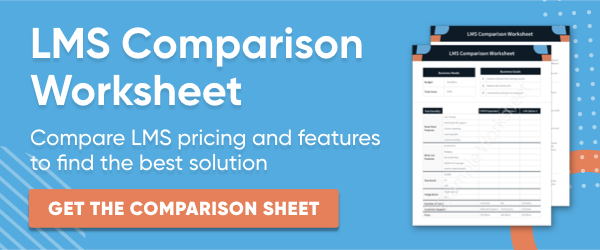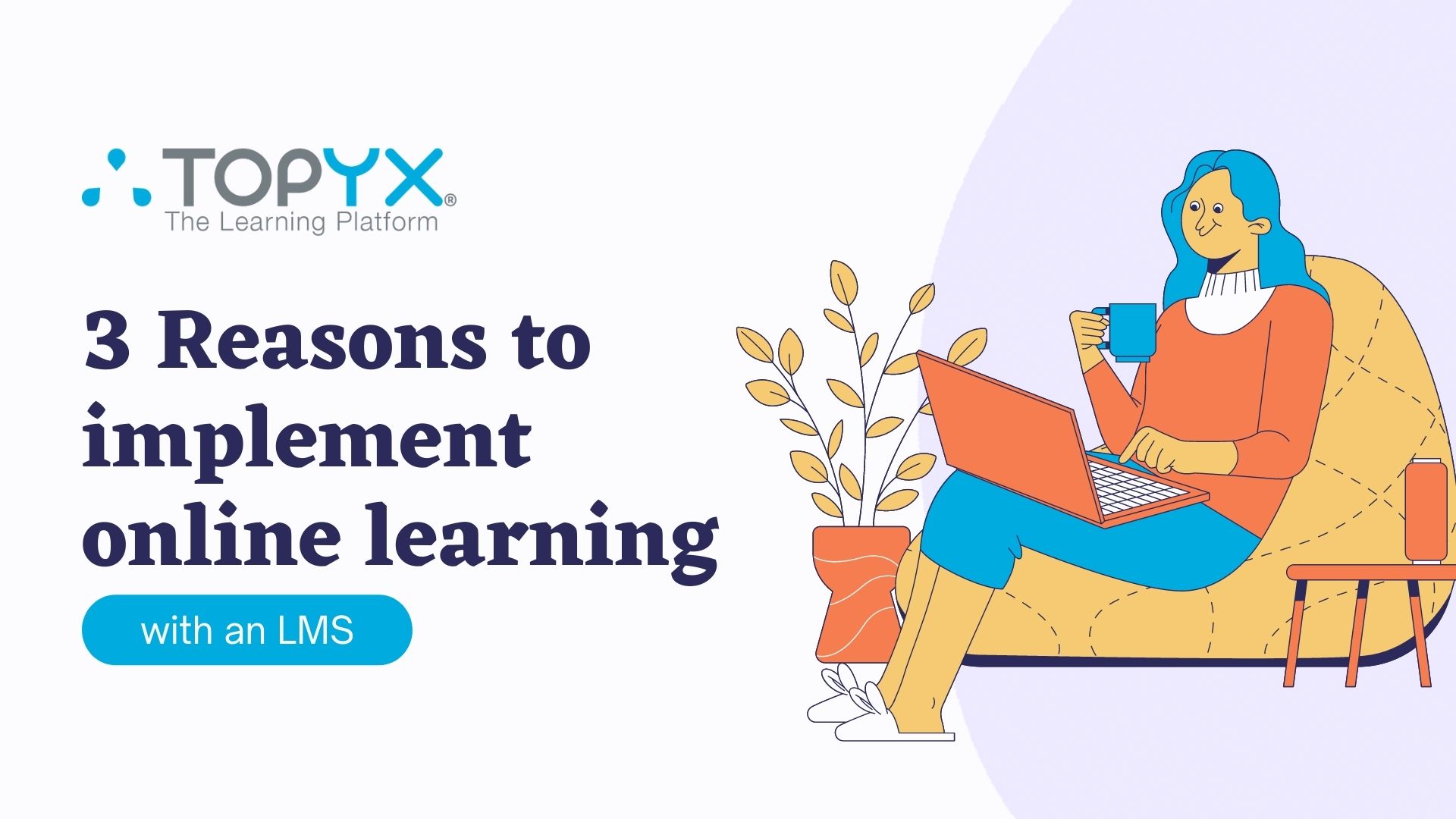How much does LMS software cost? When selecting a learning management system organizations must take several factors into account:
- Features
- Accessibility
- Integrations
- Content
All of which vary widely from one LMS to the next. However, one point of interest to every organization is cost, which can also vary widely. Cost is a critical factor in determining which LMS System can best meet your organization’s needs because if an LMS doesn’t fit in your budget or create significant savings in terms of training costs, it may not be a feasible investment for your organization.

A recent survey¹ found that 59 percent of organizations spend more than they expect to on their LMS, indicating that the majority of LMS purchases are budgeted incorrectly, possibly due to ineffective forecasting, or the effect of hidden costs and fees.
The same study found that the average annual spend for an enterprise LMS in $70,614. And that expense does not guarantee satisfaction – an estimated 48 percent of organizations² are interested in exploring new learning solutions.
To help companies better understand LMS pricing and select the best option for their business needs, we put together a guide to LMS pricing as well as sample cost estimations. Use this information when evaluating your LMS models to avoid being surprised by unexpected fees.
Common LMS Pricing Models and Fees
Variable-Price Models
LMS companies may offer a variety of pricing models, the most common of which are:
- Pay Per Learner: The most common model, prices start with a software fee and increase by a set amount as you add end users to the platform.
- Pay Per Use: Prices are based on the features, modules, or accounts used.
- Pay Per Course: Companies pay a set price for every course they host with the LMS. This is common for compliance or certification-based training.
- Licensing: Prices are based on a single product licensing fee.
For more information on LMS pricing models, check out this article: Evaluating LMS Pricing Models: What is Best for Your Organization?
The cost of the LMS may change drastically depending on the pricing model, making it of critical importance for a company to plan carefully for LMS usage before evaluating different systems.
It is also important to consider the possibility that your company may experience rapid growth during the contract period. Once an organization goes above the contracted limit of users or courses, costs may accelerate dramatically depending on what pricing model you select; that eventuality should be considered before you sign a contract.
Flat-Fee Models
A flat-fee LMS pricing model provides a set, annual amount that provides an organization with unlimited access to the LMS platform, regardless of how many users, courses, or features you need. In some cases, it can save a significant amount over per-learner or per-use models, especially for large businesses with hundreds or thousands of end users. Flat-fee models can also help with budgeting and forecasting, as costs are consistent and predictable.
Additional Cost Considerations
Regardless of the pricing model used by the LMS vendor, there may be fees that are charged in addition to the per-user or annual flat fee. Some additional costs may include:
- Implementation & setup
- Custom integrations
- Re-licensing
- Upgrades and additional users
- Maintenance & support
These additional costs aren’t applicable to everyone, but should be considered before you make a final decision on which LMS option is right for your business. Technology companies that use an LMS to train their customers, for example, will likely want to consider webinar integrations so they can host live and recorded demonstrations on product use. Such an integration will likely increase LMS costs.
Evaluate your business’s unique training needs, fitting additional requirements into the categories above, if necessary. When comparing systems, ask for an LMS overview from each vendor that clearly outlines your needs and whether or not they’ll require an additional fee.
Sample Cost Estimations
Per user is by far the most common LMS pricing model, while flat fee models tend to be the most popular.
A small to mid-sized enterprise (SME) that is considering an LMS implementation will often be drawn to companies that offer per-user charges. This is attractive to smaller companies, because the up-front costs tend to be lower and companies pay only for what they use. Larger companies may want to consider flat-fee models that are easier to scale to large employee bases and growing businesses.
Let’s look at three possible pricing situations for per user and flat fee LMS systems and how they affect companies of varying sizes differently.
Vendor 1: Standardized Per User Fee
Charges $5/user/month for an unlimited number of employees.
A static fee of $5 per user seems reasonable, and is easy to understand and manage. For a small company that does not anticipate any rapid growth for the contract period, this may be a cost-effective solution. As a company grows, however, a standardized per-user fee can quickly grow out of control. Here’s how the pricing breaks down:
- Relatively small company with 150 employees: $270/mo or $3,150/year
- Mid-size company with 500 employees: $550/mo or $6,000/year
- Re-licensing
- Upgrades and additional users
- Large company with 2,500 employees: $2,000/mo or $24,000/year
Vendor 2: Graded Per User Fee
Charges $1.75/user/month for up to 500 employees; cost per user declines at 500 and 1000 users.
Graded per user fee LMS systems are more affordable for larger companies. They apply what is essentially a type of bulk discount that allows you to reduce per user costs as you add learners to the system. Here’s the cost breakdown:
Relatively small company with 150 employees: $270/mo or $3,150/year
Mid-size company with 500 employees: $550/mo or $6,000/year
Large company with 2,500 employees: $2,000/mo or $24,000/year
Notice that charges don’t jump dramatically between 150 employees and 500 employees. That’s because the graded fee kicks in at 500 users, effectively charging around $1.10 per user after 500 employees. The fee is further reduced as you continue adding users, ultimately declining to just $0.80 per user. Despite the discount, however, large companies still pay a significant base rate.
Again, these cost applies to basic services, but may not include additional costs or hidden fees such as implementation, integration, upgrades and support. It’s those additional costs that often lead increase these fees, contributing to the average enterprise LMS cost of $70,614.
In most cases a large company will be best served by enterprise solutions, which are more likely to use a flat monthly or annual fee. Paying per-user would be cost-prohibitive for a large enterprise, and additional fees for access to premium content or customization will have a greater impact at a large organization.
Vendor 3: Flat Fee
$19,500/year for up to 3,000 employees
Flat fee models aren’t right for every enterprise, but they have major benefits depending on organization size. For instance, $19,500 per year might be a lot of money for a relatively small company with just 150 employees, but mid-size and large businesses will likely view the model differently. Using the example above, a large organization of 2500 employees would pay $150,000 per year for Vendor 1’s flat fee, and $24,000 per year for Vendor 2’s graded fee.
Relatively small company with 150 employees: $1,625/mo or $19,500/year
Mid-size company with 500 employees: $1,625/mo or $19,500/year
Large company with 2,500 employees: $1,625/mo or $19,500/year
When compared to our previous cost estimates, only the company with 150 employees would pay significantly more with the flat-fee model. Companies with 500 employees and above save a significant amount with this flat-fee models.
If Vendor 3’s numbers were broken down, the company would be charged only $0.65 per user per month – and could add an additional 500 users without being responsible for any extra charges.
That said, the term “flat fee” can be a bit of a misnomer. Even flat-fee LMS providers typically offer several pricing tiers geared toward small, medium, and large enterprises. Many companies have well over 3,000 employees, for instance, and may choose a higher tier with a higher base rate that still ultimately saves them thousands of dollars compared to per-user models.
Evaluate Features, Price, and Additional Fees
Based on Budget and Business Needs
In small- and medium-sized companies, a period of rapid growth – or downsizing – can drastically affect the charges associated with a company LMS. Large companies tend to be more stable, and the changes in employment levels have a lesser effect on the company as a whole (although they can still represent a large yearly spend, depending on the LMS pricing model).
Both small and large companies should have realistic long-term plans in place, and those plans can be used to inform the LMS decision-making process.
An LMS represents a significant investment for an organization, but the right system can provide many benefits. In addition to providing a systematic method for delivering information throughout the company and reducing overall training costs, LMS systems may also contribute to improved employee engagement and retention, reduced turnover, and improved employee performance.
For the best results, do an LMS features comparison and evaluate the cost of each system to determine which option is most likely to fit your budget and align with business goals. Most importantly, make sure to ask every vendor you talk with about additional fees for implementation, training, integrations, and other elements. Map out everything you need before making a final decision to ensure you’re not surprised with an annual cost that far exceeds your estimates.
Resources:
¹ https://www.capterra.com/learning-management-system-software/user-research
² https://elearningindustry.com/brandon-hall-group-elearning-market-trends-2016-learning-management-system






